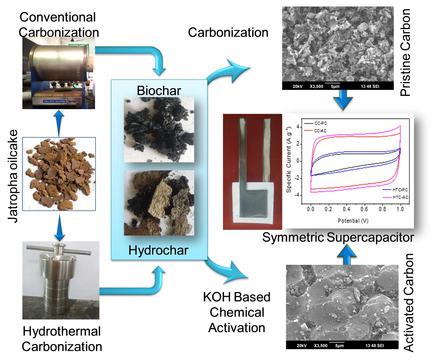当前位置:
X-MOL 学术
›
ChemistrySelect
›
论文详情
Our official English website, www.x-mol.net, welcomes your
feedback! (Note: you will need to create a separate account there.)
Jatropha Oil Cake Based Activated Carbon for Symmetric Supercapacitor Application: A Comparative Study on Conventional and Hydrothermal Carbonization Processes
ChemistrySelect ( IF 1.9 ) Pub Date : 2020-01-27 , DOI: 10.1002/slct.201903492 M. Siva Sankari 1 , S. Vivekanandhan 1
ChemistrySelect ( IF 1.9 ) Pub Date : 2020-01-27 , DOI: 10.1002/slct.201903492 M. Siva Sankari 1 , S. Vivekanandhan 1
Affiliation

|
Jatropha oilcake (JOC), a major agro industrial co‐product was effectively converted into activated carbons employing KOH mediated chemical process for supercapacitor applications. The activated carbons were synthesized by employing conventional (CC) as well as hydrothermal carbonization (HTC) processes and investigated their impact on their physicochemical properties. The graphitization degree of the pristine and activated biocarbons was investigated through XRD and RAMAN analysis. BET surface area analysis showed the enhanced specific surface area of the pristine carbons from 71.5 (CC) and 48.1 (HTC) m2/g into 678.1 (CC) and 746.7 m2/g (HTC) through KOH activation. The synthesized activated biocarbon materials were explored as the electrode material for supercapacitors. The electrochemical analysis of the fabricated symmetric supercapacitor showed the specific capacitance of 145.76 F/g and 174.78 F/g at 1 A/g for the activated biocarbons obtained respectively through conventional and hydrothermal carbonization processes. Also, they showed considerable energy density of 5.28 Whkg−1 (CC) and 6.49 Whkg−1 (HTC) at a power density of 248.6 and 265.09 W kg−1. Among the two different approaches, the hydrothermal process showed great promise for the production of renewable biomass‐derived activated biocarbon materials for supercapacitor applications.
中文翻译:

麻疯树油饼基活性炭在对称超级电容器中的应用:常规和水热碳化工艺的比较研究
麻疯树油饼(JOC)是一种主要的农业工业副产品,采用KOH介导的化学工艺将其有效地转化为活性炭,用于超级电容器。通过使用常规(CC)以及水热碳化(HTC)工艺合成了活性炭,并研究了它们对其理化性质的影响。通过XRD和RAMAN分析研究了原始和活性生物碳的石墨化程度。BET表面积分析表明,原始碳的比表面积从71.5(CC)和48.1(HTC)m 2 / g提高到678.1(CC)和746.7 m 2/ g(HTC)通过KOH激活。探索了合成的活性生物碳材料作为超级电容器的电极材料。所制造的对称超级电容器的电化学分析表明,分别通过常规和水热碳化方法获得的活性生物炭在1 A / g时的比电容分别为145.76 F / g和174.78 F / g。而且,它们在248.6和265.09W kg -1的功率密度下显示出相当大的5.28 Whkg -1(CC)和6.49 Whkg -1(HTC)的能量密度。在这两种不同的方法中,水热工艺显示出可用于超级电容器的可再生生物质衍生的活性生物碳材料的生产前景。
更新日期:2020-01-27
中文翻译:

麻疯树油饼基活性炭在对称超级电容器中的应用:常规和水热碳化工艺的比较研究
麻疯树油饼(JOC)是一种主要的农业工业副产品,采用KOH介导的化学工艺将其有效地转化为活性炭,用于超级电容器。通过使用常规(CC)以及水热碳化(HTC)工艺合成了活性炭,并研究了它们对其理化性质的影响。通过XRD和RAMAN分析研究了原始和活性生物碳的石墨化程度。BET表面积分析表明,原始碳的比表面积从71.5(CC)和48.1(HTC)m 2 / g提高到678.1(CC)和746.7 m 2/ g(HTC)通过KOH激活。探索了合成的活性生物碳材料作为超级电容器的电极材料。所制造的对称超级电容器的电化学分析表明,分别通过常规和水热碳化方法获得的活性生物炭在1 A / g时的比电容分别为145.76 F / g和174.78 F / g。而且,它们在248.6和265.09W kg -1的功率密度下显示出相当大的5.28 Whkg -1(CC)和6.49 Whkg -1(HTC)的能量密度。在这两种不同的方法中,水热工艺显示出可用于超级电容器的可再生生物质衍生的活性生物碳材料的生产前景。











































 京公网安备 11010802027423号
京公网安备 11010802027423号